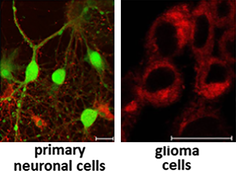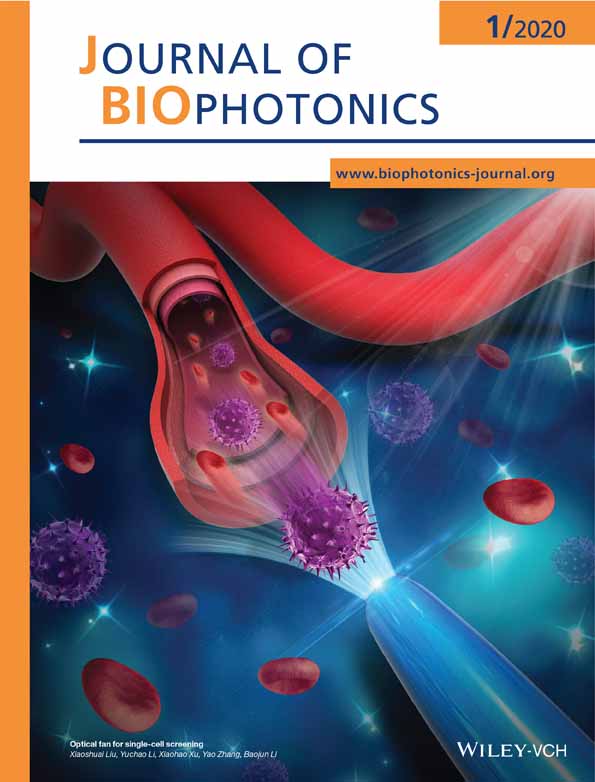Effect of novel porphyrazine photosensitizers on normal and tumor brain cells
Tatiana A. Mishchenko
Institute of Biology and Biomedicine, Lobachevsky State University of Nizhni Novgorod, Nizhny Novgorod, Russian Federation
Search for more papers by this authorVictoria D. Turubanova
Institute of Biology and Biomedicine, Lobachevsky State University of Nizhni Novgorod, Nizhny Novgorod, Russian Federation
Search for more papers by this authorElena V. Mitroshina
Institute of Biology and Biomedicine, Lobachevsky State University of Nizhni Novgorod, Nizhny Novgorod, Russian Federation
Search for more papers by this authorRazan Alzeibak
Institute of Biology and Biomedicine, Lobachevsky State University of Nizhni Novgorod, Nizhny Novgorod, Russian Federation
Search for more papers by this authorNina N. Peskova
Institute of Biology and Biomedicine, Lobachevsky State University of Nizhni Novgorod, Nizhny Novgorod, Russian Federation
Search for more papers by this authorSvetlana A. Lermontova
G.A. Razuvaev Institute of Organometallic Chemistry of the Russian Academy of Sciences, Nizhny Novgorod, Russian Federation
Search for more papers by this authorLarisa G. Klapshina
G.A. Razuvaev Institute of Organometallic Chemistry of the Russian Academy of Sciences, Nizhny Novgorod, Russian Federation
Search for more papers by this authorIrina V. Balalaeva
Institute of Biology and Biomedicine, Lobachevsky State University of Nizhni Novgorod, Nizhny Novgorod, Russian Federation
Search for more papers by this authorMaria V. Vedunova
Institute of Biology and Biomedicine, Lobachevsky State University of Nizhni Novgorod, Nizhny Novgorod, Russian Federation
Maria V. Vedunova and Dmitri V. Krysko share senior authorship.Search for more papers by this authorCorresponding Author
Dmitri V. Krysko
Institute of Biology and Biomedicine, Lobachevsky State University of Nizhni Novgorod, Nizhny Novgorod, Russian Federation
Cell Death Investigation and Therapy (CDIT) Laboratory, Department of Human Structure and Repair, Ghent University, Ghent, Belgium
Cancer Research Institute Ghent, Ghent, Belgium
Maria V. Vedunova and Dmitri V. Krysko share senior authorship.Correspondence
Dr Dmitri V. Krysko, Cell Death Investigation and Therapy (CDIT) Laboratory, Department of Human Structure and Repair, Ghent University, C. Heymanslaan 10, Building B3, 4th floor, Ghent 9000, Belgium.
Email: [email protected]
Search for more papers by this authorTatiana A. Mishchenko
Institute of Biology and Biomedicine, Lobachevsky State University of Nizhni Novgorod, Nizhny Novgorod, Russian Federation
Search for more papers by this authorVictoria D. Turubanova
Institute of Biology and Biomedicine, Lobachevsky State University of Nizhni Novgorod, Nizhny Novgorod, Russian Federation
Search for more papers by this authorElena V. Mitroshina
Institute of Biology and Biomedicine, Lobachevsky State University of Nizhni Novgorod, Nizhny Novgorod, Russian Federation
Search for more papers by this authorRazan Alzeibak
Institute of Biology and Biomedicine, Lobachevsky State University of Nizhni Novgorod, Nizhny Novgorod, Russian Federation
Search for more papers by this authorNina N. Peskova
Institute of Biology and Biomedicine, Lobachevsky State University of Nizhni Novgorod, Nizhny Novgorod, Russian Federation
Search for more papers by this authorSvetlana A. Lermontova
G.A. Razuvaev Institute of Organometallic Chemistry of the Russian Academy of Sciences, Nizhny Novgorod, Russian Federation
Search for more papers by this authorLarisa G. Klapshina
G.A. Razuvaev Institute of Organometallic Chemistry of the Russian Academy of Sciences, Nizhny Novgorod, Russian Federation
Search for more papers by this authorIrina V. Balalaeva
Institute of Biology and Biomedicine, Lobachevsky State University of Nizhni Novgorod, Nizhny Novgorod, Russian Federation
Search for more papers by this authorMaria V. Vedunova
Institute of Biology and Biomedicine, Lobachevsky State University of Nizhni Novgorod, Nizhny Novgorod, Russian Federation
Maria V. Vedunova and Dmitri V. Krysko share senior authorship.Search for more papers by this authorCorresponding Author
Dmitri V. Krysko
Institute of Biology and Biomedicine, Lobachevsky State University of Nizhni Novgorod, Nizhny Novgorod, Russian Federation
Cell Death Investigation and Therapy (CDIT) Laboratory, Department of Human Structure and Repair, Ghent University, Ghent, Belgium
Cancer Research Institute Ghent, Ghent, Belgium
Maria V. Vedunova and Dmitri V. Krysko share senior authorship.Correspondence
Dr Dmitri V. Krysko, Cell Death Investigation and Therapy (CDIT) Laboratory, Department of Human Structure and Repair, Ghent University, C. Heymanslaan 10, Building B3, 4th floor, Ghent 9000, Belgium.
Email: [email protected]
Search for more papers by this authorAbstract
Photodynamic therapy (PDT) is a clinically approved procedure for targeting tumor cells. Though several different photosensitizers have been developed, there is still much demand for novel photosensitizers with improved properties. In this study we aim to characterize the accumulation, localization and dark cytotoxicity of the novel photosensitizers developed in-house derivatives of porphyrazines (pz I-IV) in primary murine neuronal cells, as well as to identify the concentrations at which pz still effectively induces death in glioma cells yet is nontoxic to nontransformed cells. The study shows that incubation of primary neuronal and glioma cells with pz I-IV leads to their accumulation in both types of cells, but their rates of internalization, subcellular localization and dark toxicity differ significantly. Pz II was the most promising photosensitizer. It efficiently killed glioma cells while remaining nontoxic to primary neuronal cells. This opens up the possibility of evaluating pz II for experimental PDT for glioma.

CONFLICTS OF INTEREST
The authors declare that there is no conflict of interest regarding the publication of this article.
REFERENCES
- 1I. Jovcevska, N. Kocevar, R. Komel, Mol. Clin. Oncol. 2013, 1, 935.
- 2T. Tykocki, M. Eltayeb, J. Clin. Neurosci. 2018, 54, 7.
- 3C. J. Fisher, L. Lilge, J. Innov. Opt. Heal. Sci. 2015, 8, 1530005.
- 4P. Agostinis, K. Berg, K. A. Cengel, T. H. Foster, A. W. Girotti, S. O. Gollnick, S. M. Hahn, M. R. Hamblin, A. Juzeniene, D. Kessel, M. Korbelik, J. Moan, P. Mroz, D. Nowis, J. Piette, B. C. Wilson, J. Golab, CA Cancer J. Clin. 2011, 61, 250.
- 5A. B. Uzdensky, E. Berezhnaya, V. Kovaleva, M. Neginskaya, M. Rudkovskii, S. Sharifulina, J. Biomed. Opt. 2015, 20, 61108.
- 6K. Mahmoudi, K. L. Garvey, A. Bouras, G. Cramer, H. Stepp, J. G. Jesu Raj, D. Bozec, T. M. Busch, C. G. Hadjipanayis, J. Neurooncol. 2019, 141, 595.
- 7L. Shi, A. Buchner, H. Pohla, T. Pongratz, A. Ruhm, W. Zimmermann, O. A. Gederaas, L. Zhang, X. Wang, H. Stepp, R. Sroka, J. Biophotonics 2019, 12, e201800468.
- 8M. A. Izquierdo, A. Vysniauskas, S. A. Lermontova, I. S. Grigoryev, N. Y. Shilyagina, I. V. Balalaeva, L. G. Klapshina, M. K. Kuimova, J. Mater. Chem. B 2015, 3, 1089.
- 9S. S. Stylli, A. H. Kaye, L. MacGregor, M. Howes, P. Rajendra, J. Clin. Neurosci. 2005, 12, 389.
- 10A. Ghosh, J. Fitzgerald, P. G. Gassman, J. Almlof, Inorg. Chem. 1994, 33, 6057.
- 11N. Y. Shilyagina, N. N. Peskova, S. A. Lermontova, A. A. Brilkina, V. A. Vodeneev, A. V. Yakimansky, L. G. Klapshina, I. V. Balalaeva, J. Biophoton. 2017, 10, 1189.
- 12D. V. Yuzhakova, S. A. Lermontova, I. S. Grigoryev, M. S. Muravieva, A. I. Gavrina, M. V. Shirmanova, I. V. Balalaeva, L. G. Klapshina, E. V. Zagaynova, Biochim. Biophys. Acta Gen. Subj. 2017, 1861, 3120.
- 13S. A. Lermontova, I. S. Grigoryev, N. Y. Shilyagina, N. N. Peskova, I. V. Balalaeva, M. V. Shirmanova, L. G. Klapshina, Russ. J. Gen. Chem. 2016, 86, 1330.
- 14S. A. Lermontova, I. S. Grigor'ev, N. N. Peskova, E. Y. Ladilina, I. V. Balalaeva, L. G. Klapshina, V. P. Boyarskii, Russ. J. Gen. Chem. 2017, 87, 479.
- 15V. Huntosova, K. Stroffekova, Cancers (Basel) 2016, 8, 93.
- 16M. Vedunova, T. Sakharnova, E. Mitroshina, M. Perminova, A. Pimashkin, Y. Zakharov, A. Dityatev, I. Mukhina, Front. Cell. Neurosci. 2013, 7, 149.
- 17M. V. Vedunova, T. A. Mishchenko, E. V. Mitroshina, I. V. Mukhina, Oxid. Med. Cell. Longev. 2015, 2015, 453901.
- 18N. Y. Shilyagina, V. I. Plekhanov, I. V. Shkunov, P. A. Shilyagina, L. V. Dubasova, A. A. Brilkina, E. A. Sokolova, I. V. Turchin, I. V. Balalaeva, Sovremennye Tehnol. V Med. 2014, 6, 15.
- 19E. H. Kim, G. Chin, G. X. Rong, K. E. Poskanzer, H. A. Clark, Acc. Chem. Res. 2018, 51, 1023.
- 20A. D. Garg, D. V. Krysko, T. Verfaillie, A. Kaczmarek, G. B. Ferreira, T. Marysael, N. Rubio, M. Firczuk, C. Mathieu, A. J. Roebroek, W. Annaert, J. Golab, P. de Witte, P. Vandenabeele, P. Agostinis, EMBO J. 2012, 31, 1062.
- 21D. V. Krysko, A. D. Garg, A. Kaczmarek, O. Krysko, P. Agostinis, P. Vandenabeele, Nat. Rev. Cancer 2012, 12, 860.
- 22T. Mishchenko, E. Mitroshina, I. Balalaeva, O. Krysko, M. Vedunova, D. V. Krysko, Biochim. Biophys. Acta Rev. Cancer 2019, 1871, 99.
- 23O. Krysko, T. L. Aaes, V. E. Kagan, K. D'Herde, C. Bachert, L. Leybaert, P. Vandenabeele, D. V. Krysko, Immunol. Rev. 2017, 280, 207.
- 24V. Huntosova, M. Novotova, Z. Nichtova, L. Balogova, M. Maslanakova, D. Petrovajova, K. Stroffekova, Toxicol. In Vitro 2017, 40, 184.
- 25T. V. Shishkina, T. A. Mishchenko, E. V. Mitroshina, O. M. Shirokova, A. S. Pimashkin, I. A. Kastalskiy, I. V. Mukhina, V. B. Kazantsev, M. V. Vedunova, Brain Res. 2018, 1678, 310.
- 26K. M. Hebeda, J. G. Wolbers, H. J. C. M. Sterenborg, W. Kamphorst, M. J. C. Vangemert, H. A. M. Vanalphen, J. Photochem. Photobiol. B 1995, 27, 85.




